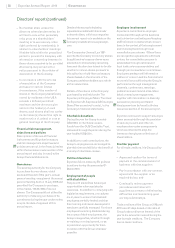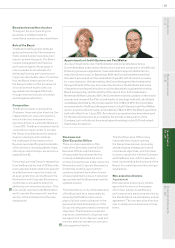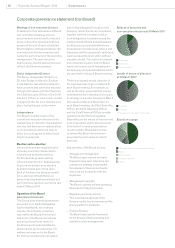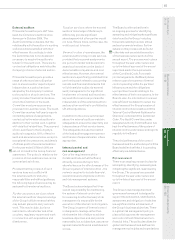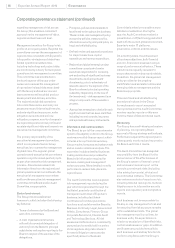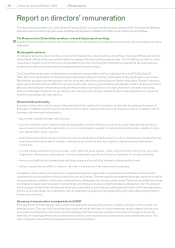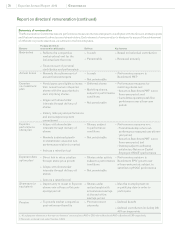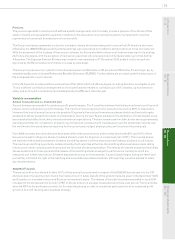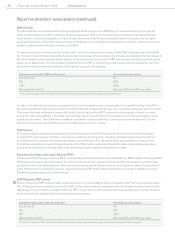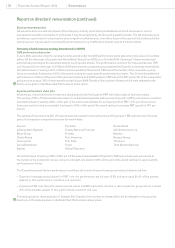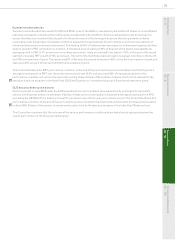Experian 2010 Annual Report Download - page 67
Download and view the complete annual report
Please find page 67 of the 2010 Experian annual report below. You can navigate through the pages in the report by either clicking on the pages listed below, or by using the keyword search tool below to find specific information within the annual report.
65
Introduction
2 – 11
Business review
12 – 51
Financial statements
85 – 160
Governance
52 – 84
External auditors
PricewaterhouseCoopers LLP have
been the Company’s auditors since
demerger in October 2006. The
Audit Committee considers that the
relationship with the auditors is working
well and remains satised with their
effectiveness. Accordingly, to date
the Committee has not considered it
necessary to require the auditors to
tender for the audit work. There are no
contractual obligations restricting the
Company’s choice of external auditor.
PricewaterhouseCoopers provide a
range of other services to Experian
and, to ensure auditor objectivity and
independence, a policy has been
adopted by the Company in relation
to the provision of such services. The
policy includes nancial limits above
which the Chairman of the Audit
Committee must pre-approve any
proposed non-audit services. The Audit
Committee receives half-yearly reports
containing details of assignments
carried out by the external auditors in
addition to their normal work, together
with details of related fees. The payment
of non-audit fees to the Company’s
auditors is capped at 100% of fees for
audit and assurance services, except in
exceptional circumstances, and details
of all fees paid to the external auditors
for the year ended 31 March 2010 are
set out in note 8 to the Group nancial
statements. The policy in relation to the
provision of non-audit services can be
summarised as follows.
Provided that the provision of such
services does not conict with
the external auditors’ statutory
responsibilities and ethical guidance,
the following types of services may be
assigned to the external auditors:
Further assurance services:
where
the external auditors’ deep knowledge
of the Group’s affairs means that they
may be best placed to carry out such
work. This may include, but is not
restricted to, shareholder and other
circulars, regulatory reports and work
in connection with acquisitions and
divestments.
Taxation services:
where the external
auditors’ knowledge of the Group’s
affairs may provide signicant
advantages which other parties would
not have. Where this is not the case, the
work is put out to tender.
General:
in other circumstances, the
external auditors may provide services
provided that proposed assignments
are put out to tender and decisions to
award work are taken on the basis of
demonstrable competence and cost
effectiveness. However, the external
auditors are specically prohibited from
performing work related to accounting
records and nancial statements that
will ultimately be subject to external
audit; management of or signicant
involvement in internal audit services;
any work that could compromise the
independence of the external auditors;
and any other work that is prohibited by
UK ethical guidance.
In addition to the policy summarised
above, the external auditors maintain
safeguards to ensure the objectivity and
independence of their service teams.
The safeguards include the rotation
of the lead audit engagement partner
and the use of separate teams, where
appropriate.
Internal control and
risk management
One of the requirements of the
Combined Code is that the Board,
annually, reviews and reports to
shareholders on the effectiveness of the
Group’s system of internal control – the
review is required to include nancial,
operational and compliance controls
and risk management systems.
The Board acknowledges that it has
overall responsibility for maintaining
the system of internal control and
for reviewing its effectiveness; while
management is responsible for the
execution of the internal control system.
The Group’s system of internal control
is designed to manage rather than
eliminate the risk of failure to achieve
business objectives and can provide
reasonable, but not absolute, assurance
against material nancial misstatement
or loss.
The Board conrms that there is
an ongoing process for identifying,
assessing and mitigating the signicant
risks faced by the Group, including
those risks relating to social, ethical
and environmental matters. Further
details on this process can be found
in the risks and uncertainties section
of the business review section of the
annual report. The process was in place
throughout the year under review and
up to the date of approval of the annual
report and meets the requirements
of the Combined Code. For certain
joint arrangements, the Board places
reliance upon the systems of internal
control operating within the partners’
infrastructure and the obligations
upon partners’ boards relating to the
effectiveness of their own systems. In the
Board’s view, the information it received
was sufcient to enable it to review the
effectiveness of the Group’s system of
internal control in accordance with the
‘Internal Control Revised Guidance for
Directors’ contained in the Combined
Code. The Audit Committee, under
delegated authority from the Board, has
kept the effectiveness of the system of
internal control under review and reports
regularly to the Board.
The principal features of the control
framework and the methods by which the
Board satises itself that it is operating
effectively are detailed below.
Risk assessment
There is an ongoing process in place for
anticipating, identifying, assessing and
mitigating the signicant risks faced by
the Group. The process has operated
throughout the year under review and
up to the date of approval of the annual
report.
The Group’s risk management and
governance framework is designed to
support the anticipation, identication,
assessment and mitigation of risks that
are signicant to the achievement of
the Group’s business objectives. There
is a global risk management policy in
place which governs the management
and control of both nancial and non-
nancial risks. The policy describes the
global risk framework and denes risk
management principles and expectations
111
34



